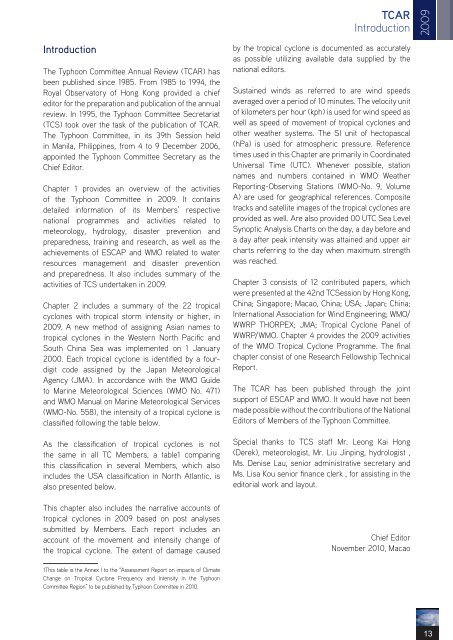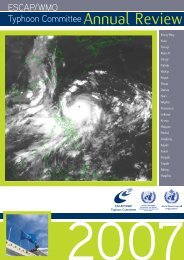TCAR - Typhoon Committee
TCAR - Typhoon Committee
TCAR - Typhoon Committee
Create successful ePaper yourself
Turn your PDF publications into a flip-book with our unique Google optimized e-Paper software.
Introduction<br />
The <strong>Typhoon</strong> <strong>Committee</strong> Annual Review (<strong>TCAR</strong>) has<br />
been published since 1985. From 1985 to 1994, the<br />
Royal Observatory of Hong Kong provided a chief<br />
editor for the preparation and publication of the annual<br />
review. In 1995, the <strong>Typhoon</strong> <strong>Committee</strong> Secretariat<br />
(TCS) took over the task of the publication of <strong>TCAR</strong>.<br />
The <strong>Typhoon</strong> <strong>Committee</strong>, in its 39th Session held<br />
in Manila, Philippines, from 4 to 9 December 2006,<br />
appointed the <strong>Typhoon</strong> <strong>Committee</strong> Secretary as the<br />
Chief Editor.<br />
Chapter 1 provides an overview of the activities<br />
of the <strong>Typhoon</strong> <strong>Committee</strong> in 2009. It contains<br />
detailed information of its Members’ respective<br />
national programmes and activities related to<br />
meteorology, hydrology, disaster prevention and<br />
preparedness, training and research, as well as the<br />
achievements of ESCAP and WMO related to water<br />
resources management and disaster prevention<br />
and preparedness. It also includes summary of the<br />
activities of TCS undertaken in 2009.<br />
Chapter 2 includes a summary of the 22 tropical<br />
cyclones with tropical storm intensity or higher, in<br />
2009. A new method of assigning Asian names to<br />
tropical cyclones in the Western North Pacific and<br />
South China Sea was implemented on 1 January<br />
2000. Each tropical cyclone is identified by a fourdigit<br />
code assigned by the Japan Meteorological<br />
Agency (JMA). In accordance with the WMO Guide<br />
to Marine Meteorological Sciences (WMO No. 471)<br />
and WMO Manual on Marine Meteorological Services<br />
(WMO-No. 558), the intensity of a tropical cyclone is<br />
classified following the table below.<br />
As the classification of tropical cyclones is not<br />
the same in all TC Members, a table1 comparing<br />
this classification in several Members, which also<br />
includes the USA classification in North Atlantic, is<br />
also presented below.<br />
This chapter also includes the narrative accounts of<br />
tropical cyclones in 2009 based on post analyses<br />
submitted by Members. Each report includes an<br />
account of the movement and intensity change of<br />
the tropical cyclone. The extent of damage caused<br />
1This table is the Annex I to the “Assessment Report on impacts of Climate<br />
Change on Tropical Cyclone Frequency and Intensity in the <strong>Typhoon</strong><br />
<strong>Committee</strong> Region” to be published by <strong>Typhoon</strong> <strong>Committee</strong> in 2010.<br />
<strong>TCAR</strong><br />
Introduction<br />
by the tropical cyclone is documented as accurately<br />
as possible utilizing available data supplied by the<br />
national editors.<br />
Sustained winds as referred to are wind speeds<br />
averaged over a period of 10 minutes. The velocity unit<br />
of kilometers per hour (kph) is used for wind speed as<br />
well as speed of movement of tropical cyclones and<br />
other weather systems. The SI unit of hectopascal<br />
(hPa) is used for atmospheric pressure. Reference<br />
times used in this Chapter are primarily in Coordinated<br />
Universal Time (UTC). Whenever possible, station<br />
names and numbers contained in WMO Weather<br />
Reporting-Observing Stations (WMO-No. 9, Volume<br />
A) are used for geographical references. Composite<br />
tracks and satellite images of the tropical cyclones are<br />
provided as well. Are also provided 00 UTC Sea Level<br />
Synoptic Analysis Charts on the day, a day before and<br />
a day after peak intensity was attained and upper air<br />
charts referring to the day when maximum strength<br />
was reached.<br />
Chapter 3 consists of 12 contributed papers, which<br />
were presented at the 42nd TCSession by Hong Kong,<br />
China; Singapore; Macao, China; USA; Japan; China;<br />
International Association for Wind Engineering; WMO/<br />
WWRP THORPEX; JMA; Tropical Cyclone Panel of<br />
WWRP/WMO. Chapter 4 provides the 2009 activities<br />
of the WMO Tropical Cyclone Programme. The final<br />
chapter consist of one Research Fellowship Technical<br />
Report.<br />
The <strong>TCAR</strong> has been published through the joint<br />
support of ESCAP and WMO. It would have not been<br />
made possible without the contributions of the National<br />
Editors of Members of the <strong>Typhoon</strong> <strong>Committee</strong>.<br />
Special thanks to TCS staff Mr. Leong Kai Hong<br />
(Derek), meteorologist, Mr. Liu Jinping, hydrologist ,<br />
Ms. Denise Lau, senior administrative secretary and<br />
Ms. Lisa Kou senior finance clerk , for assisting in the<br />
editorial work and layout.<br />
Chief Editor<br />
November 2010, Macao<br />
2009<br />
13

















